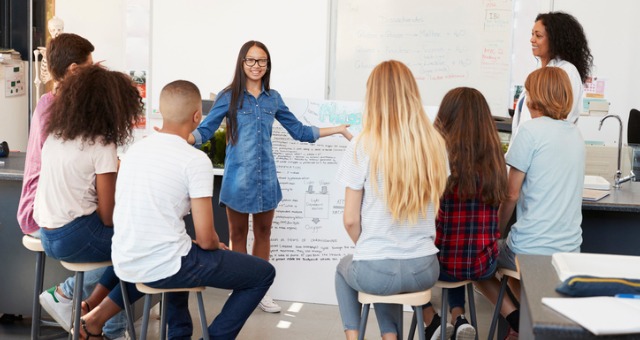Forward thinking might be exactly what teachers strive for in the classroom, but it may require some backwards design. Beth Harrison, PhD, director of the Office of Learning Resources at the University of Dayton, discusses how backwards design can offer faculty members a focused approach to planning curriculum—with the added benefit of adding accessibility for all students.
Normally, teachers think about what type of content they want to present and what kind of assignments they want to implement. They establish a syllabus, and finally, they create a final exam to test the students’ overall understanding.
Instead of creating a curriculum that drives toward an ultimate end goal, backwards design requires faculty to start with their end goals and align every course-design choice around these objectives.
“Backwards design asks us to think in the opposite direction, in the opposite order,” Harrison says.
Step 1: Finding the kernels
Once you have a backwards design mindset, there are a series of questions to should consider.
“I actually like to ask the question in this way: What do I want my students to know, be able to do, or value three years after this course is over?” Harrison asks. Most likely students won’t soak up every ounce of information you present in a semester, but it’s important to focus on the “kernels” that are most important. These goals and kernels must be obtainable outcomes for students to achieve, and ultimately, that’s the first step.
Step 2: Tools to observe the evidence
The second step involves creating a method for assessing if students have attained the course outcomes and goals. How will you know, through observable evidence, that your students are progressing toward these end ambitions? Harrison says observable evidence isn’t necessarily something we see with our eyes, instead it could come from exams, assignments, or projects students do in class.
Step 3: One step back
The third step requires faculty to take one step back and establish what their students need to do in order for them to experience the intended course goals. There needs to be some type of evidence and/or demonstration that shows a student has met the learning objectives. Harrison says this step is key in knowing what students need in order to excel, while also effectively demonstrating their learning.
So, what do students need? Harrison says they need content and information, which they can get from you in a variety of ways. This could be from assignments and assessments, such as papers, essays, or exams. It could also include projects, activities, or hands-on practice, but eventually you’ll need evidence of each student’s learning progression.
“So, that evidence might help us understand that, ‘Oh, I need to go back and spend another day, another class period or two, going over this some more or giving them more practice because they don’t have it yet,’” Harrison says.
Creative Products
Cue creative products, which can help cultivate the learning process in a way that accommodates learning differences among students Creative products might include having students draw a comprehensive picture of a biology cycle or it might be drawing a concept map. These types of creative products, when constructed via backward-design principles, constitute both practice and evidence of a student’s knowledge while meeting course objectives.
When creating these types of assignments, Harrison says to get in the mindset of backwards thinking. Start with what you want students to get out of the assignment and then generate a product that adheres to your goals. Sometimes, finding other mediums helps foster a creative product and stimulates an accessible classroom environment.
For instance, you can give students choices and adapt assignments to cater to everyone. This may include implementing variety within your assignments, and having students write a paper, create a poster, work together on a group project, or construct/build something. This means every student has the opportunity to flourish in at least one medium and they can try something new.
“In the end, our goal really is to provide equitable opportunity for students to achieve your course goals,” Harrison says.
Harrison delves deeper into using backwards design to curate creative courses that are accessible to each and every student in her 20-Minute Mentor program called, How Can Backward Design Make My Courses More Accessible? In this program, Harrison tells the story of a communication professor who adapted their class for a student who could not speak and had a breathing apparatus in order to make the class more accessible.

